Editor’s note: Brian Kilcourse is managing partner at Retail Systems Research, San Francisco. This is an edited version of a post that originally appeared under the title, “Amazon, internet shopping and rural America.”
 The scene at the local U.S. Post Office was chaotic. Although three windows were open, two postal agents were somewhere in the back of the building searching for parcels, while Larry, the lone guy at the front window, was trying to deal with yet another irritated Amazon shopper who wanted to know why the USPS truck didn’t drop off the package “like UPS.” A line of similarly irritated locals snaked out through the door. Welcome to an Amazon Christmas 2019, rural America-style.
The scene at the local U.S. Post Office was chaotic. Although three windows were open, two postal agents were somewhere in the back of the building searching for parcels, while Larry, the lone guy at the front window, was trying to deal with yet another irritated Amazon shopper who wanted to know why the USPS truck didn’t drop off the package “like UPS.” A line of similarly irritated locals snaked out through the door. Welcome to an Amazon Christmas 2019, rural America-style.
Well, first things first. Amazon doesn’t give Prime shoppers a choice in how a package gets delivered. I don’t know how Amazon decides to ship a package via UPS, USPS or via its own network of trucks, but I do know that the shopper can’t decide. A July 2019 column on Business Insider pointed out that in the years 2013-2018, Amazon shipments via UPS dropped significantly from 49% to 22%, while USPS shipments rose from 33% to 44%, and Amazon truck deliveries rose from nothing to 26%.
Secondly, what’s up with USPS deliveries to rural shoppers? Well, according to the U.S. Postal Service’s General Guidelines and Policies for Rural Delivery:
Mailbox must be in the rural carrier's line of travel
For Accountable mail items and oversized parcels (not postage due), the carrier must try to gain the attention of the recipient, which includes honking their horn, in order to get them to come to the vehicle. If the customer doesn't come out and the house/delivery point is within 1/2 mile of the line of travel AND has a passable road, the carrier should attempt to deliver it. Otherwise, the carrier will leave PS Form 3849 and the customer will have to make arrangements to obtain the item.
In other words, Amazon shoppers who live more than half of a mile from a county maintained road should plan on having to pick up their parcels at the local post office. I don’t know if my rural Northern California county is representative of most rural communities in America or not, but I do know that most people live on private, not public, roads, some which wind deep into the Sierra foothills.
Third, let’s talk about Larry the Post Office guy for a moment. An October 2018 article published on the website medium.com made the point that “for all its dominance and efficiency, Amazon relies on a dusty, centuries-old system to deliver at least a third – and possibly as much as half – of its packages around the country: the United States Postal Service.” The author interviewed USPS employees about the Amazon-induced workload. One postal worker explained:
“It’s a network they [Amazon] can tap into and just feed their packages through without having to establish their own network. It’s the dependability … There’s also just no limit to how much USPS will make us work … In my office, the worst I’ve heard is 17 days in a row. But . ... there are people who work months in a row without a day off, especially around the holidays, with literally no day off.”
That certainly explains Larry’s bedraggled demeanor!
E-commerce and the bigger picture
All of this has got me thinking about the digital divide. While technology thinkers at one point thought that the internet would narrow that divide, internet shopping might be making it worse.

We live in a bucolic part of Northern California by choice, not out of necessity. Like a lot of San Francisco Bay Area ex-patriots (not-too-affectionately called “flatlanders” by the locals), we expect certain things like hi-speed internet access, delivery service to our door, etc., and can afford to pay for the upcharge to have those niceties. For example, if I am willing to pay $200/month for a 15 Mbps internet connection via a line-of-sight infrared connection to a nearby access tower, I can have it. But compared to a modern urban plan (for example Xfinity’s 1,000 Mbps) my rural option is both slow and too expensive. It doesn’t matter – I’ve got to have it, and so I pay for it. I’m also not opposed to paying a few extra bucks to get an item shipped via the carrier of choice (in my case, United Parcel, since “our driver” is more than happy to drive up the road).
But not everyone in rural America can be so cavalier. In the place where I live, the median family household income is $70,000, compared to San Mateo county in the heart of Silicon Valley, which has a median family income of $108K. The inference is obvious; money is tighter up here in the woods.
One would think that e-commerce retailers would be more popular with consumers in rural areas, since their store options are much more limited (for example, my nearest Target is 20 miles away, and Walmart is 33 miles down the road). But e-commerce options – especially Amazon – are seriously constrained by both hi-speed internet availability and reasonable delivery choices.
The State of California is at least thinking about addressing the hi-speed internet issue. The state established the California Emerging Technology Fund (CETF) to assist the Governor's California Broadband Task Force in mapping the current status of broadband access in the state. Internet providers reported to the CETF that broadband is available to 96% of California residents, but 4% of the population (or about 1.4 million residents) living in rural and remote areas do not have access today. While that sounds good, the unserved portion of California is a significant percentage of the state geography. Because of that, broadband access for rural and remote areas remains a priority challenge for CETF and California.
When it comes to offering reasonable delivery choices, the jury is definitely out when it comes to Amazon. It’s an issue that the company clearly needs to address, especially since Amazon is reportedly targeting rural shoppers as a takeaway from Walmart and Dollar General. A June 2019 article in the Washington Post reported that:
“Consumers with household incomes of less than $50,000 are less likely to shop online than their more affluent peers. Those households do about 3.4 percent of their shopping online, compared to 9.7 percent for households with annual incomes of $50,000 and more, according to economists at Stanford University… roughly half of all U.S. households had Prime accounts in January, the investment firm Cowen & Co. estimates, based on quarterly surveys it conducts. But membership growth has slowed as the market among wealthier customers becomes more saturated… Low-income consumers are the group least likely to have Prime memberships. Just 31 percent of households making less than $25,000 are Prime members, compared to 60 percent of households making more than $150,000….”
That is well and good, but something has to give when it comes to shipping. According to a 2018 study published by global marketing firm Epsilon, “free shipping” was the No. 1 reason that Amazon Prime shoppers chose Amazon, even more than the No. 2 reason, “price” (70% vs. 65%). For all Amazon shoppers, the top two reasons were “price” (64%) and “free shipping” (60%). Perhaps it’s only a matter of time before Amazon either limits free Prime shipping or increases prices for rural consumers, but given the company’s value proposition, that would undermine its plans to win rural consumers over.
Larry the Post Office guy and his colleagues would probably welcome Amazon offering existing rural Prime customers some fee-for-service shipping choices. I know that if the e-commerce giant did, Larry would see a lot less of me!
